This is a Leica M5, a 35mm rangefinder camera made by Ernst Leitz GmBH in Wetzlar, West Germany between the years 1971 and 1975. The Leica M5 was the company’s first metered rangefinder, and the first ever rangefinder camera with TTL metering. In addition to its metering system, the M5 was also the first Leica M-series to abandon the design of the original M3, instead going for a taller body with a flat top plate and oversized shutter speed dial. The features and design of the camera were very controversial when it was first released, which caused sales to suffer. The M5 was produced for a very short time compared to other Leica M-series models of the era, and almost resulted in Leitz abandoning rangefinders altogether. Despite a lack of popularity when it first came out, it has earned a positive following among Leica collectors and enthusiasts in the years since.
Film Type: 135 (35mm)
Lens: 50mm f/1.4 Leica Summilux-M ASPH coated 8-elements in 5-groups
Lens Mount: Leica M-Bayonet
Focus: 2.5 feet / 0.7 meters to Infinity
Viewfinder: Coincident Image Coupled Rangefinder, 0.72x Magnification
Shutter: Cloth Focal Plane
Speeds: B, 30 – 1/1000 seconds
Exposure Meter: TTL Coupled CdS Cell w/ viewfinder match needle
Battery: 1.35v PX625 Mercury Battery
Flash Mount: Hot shoe and M and X Flash Sync, 1/50 X-Sync
Weight: 1002 grams, 675 grams (body only)
Manual: https://www.cameramanuals.org/leica_pdf/leica_m5.pdf
After four decades of continually producing some of the world’s most capable and desirable cameras, in the early 1970s, there were those who thought that Ernst Leitz, makers of Leica rangefinders and SLRs could do no wrong. From the moment the world saw the first Leica in 1925 the company’s products were in demand all the world over.
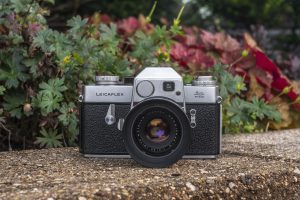
In the 1960s, Leitz took their time in designing their first SLR as they knew they were entering uncharted territory and wanted to ensure that by the time the original Leicaflex was released, it met the high standards that Leica models like the M3 and M4 had set for the company. The Leicaflex was a good camera, but was very expensive and quickly fell behind its competition in terms of features. Leitz sat on the fence too long with the Leicaflex and by the time it was released in 1964, it lacked features like TTL metering or any professional features like interchangeable prisms or motor drive couplings that other top tier cameras like the Nikon F and Topcon RE Super supported. It had a very good build quality and supported some of the best lenses in the world, but it wasn’t new.
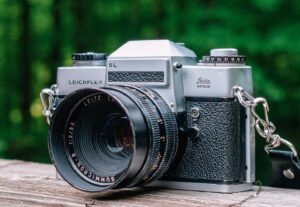
The next camera after the Leicaflex was the Leica M4 from 1966, which updated the design of the M3, but didn’t radically change much. An updated SLR called the Leicaflex SL debuted in 1968 whose biggest upgrade was TTL (through the lens) metering, in which a CdS meter in the viewfinder took an exposure reading right before the moment of exposure.
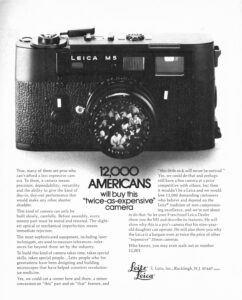
The Leicaflex SL was a huge improvement over the original model and with its metering success, Leitz decided to apply the principle to rangefinders. In 1971, Leitz would release the world’s first rangefinder camera with TTL metering. The new camera would be called the Leica M5 and was the world’s first rangefinder camera with through the lens (TTL) metering. Like the SLRs, the M5 would have a match needle display in the viewfinder and it could also show the selected shutter speed. The additional electronics required a larger body, which resulted in the first major redesign of a Leica rangefinder’s looks since the original M3. The larger body meant that a larger rewind knob would fit, although it was located on the bottom of the camera.
With an abundance of electronics inside the M5, it was not only the largest Leica rangefinder ever but also the most expensive. When it was released, the Leica M5 carried a retail price of $849 with a 50mm f/2 Summicron lens. This greatly beat the release prices of both the Leicaflex SL with 50mm f/2 Summicron-R at $639 and the Leica M4 with 50mm f/2 Summicron at $438. Each of these prices would certainly have fluctuated with time, and camera retail prices were usually a good 25% higher than actual street value, but no matter how you dissect it, the Leica M5 was a reach for most people. When adjusted for inflation, $849 compares to around $6300 today.
Initial impressions of the Leica M5 were very positive. Reviewers were excited about the presence of TTL metering, a first for a rangefinder, plus the match needle display in the viewfinder. In a review by Geoffrey Crawley published in the British Journal of Photography, he gave positive marks to the side mounted strap lugs, the large and oversized shutter speed dial that hangs over the front edge of the camera, and added comments that despite the larger size, it didn’t impede use of the camera. Compatibility with all former M-mount and LTM lenses ensured backwards compatibility, and if that wasn’t enough, a continued commitment to excellent build quality meant these would be very reliable cameras.
Unfortunately, despite some positive early reviews, demand from customers for the new camera was very low. In addition to a very high price, the change in cosmetics and general pork-ification of the camera’s dimensions proved to be an issue for customers as the Leica M5 sold poorly. While Leitz was eager to advance their lineup of cameras and prove that a TTL metered rangefinder could complete with the rash of TTL SLRs that were coming out at the same time, it appears that consumers were not as eager to fork over such a large sum of money to buy one.
The release of the M5 spelled dark times for Leitz as the Leicaflex SL wasn’t selling great either and the company reportedly lost money on every body sold. In addition, the company had stopped production of the M4 prior to the M5’s release, meaning that a lot was riding on its success. An often repeated rumor was that Leitz was so dismayed at the poor sales of the M5, they considered abandoning rangefinders altogether. Thankfully, this didn’t happen as the company reintroduced the M4 in 1975 and released an updated M4-2 model in 1977.
In total, only 33,900 Leica M5s were made (10,750 silver chrome and 23,150 black chrome) during the four years it was in production. This was just over half as many as the Leica M4 and nowhere close to the M3’s total production of 233,000 units. Upon resumption of the M4’s production, the M5 was quickly dismissed as a failure and a “rejected” model.
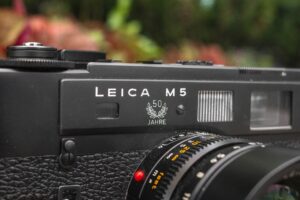
As the years passed, history has been kind to the M5 as its unique looks, historical significance, and support for the entire Leica lens system has earned it a place into the hearts of many Leica shooters and collectors. When properly serviced, the Leica M5 is as rugged and dependable as any other M-series body, the CdS meter is as accurate as anything from the era, and for those who like analog needles, is the only Leica M-series camera to offer an analog match needle system, something many people prefer over the red LEDs of the Leica M6.
In my early days of collecting, when all Leicas were out of my price range, I saw the M5 as the M-series body I was most interested in. Certainly, I would be happy to one day own any Leica, but if I had to pick one this was going to be it. I had heard of the M5’s poor reputation and that it sold for a discount compared to other models so I thought maybe one day I’d have one. I should point out that “discount” is a relative term, as yes, it didn’t cost quite as much as a M3, M4, or M6, but picking up a good working copy still put it way out of my budget. Still, I held out hope.
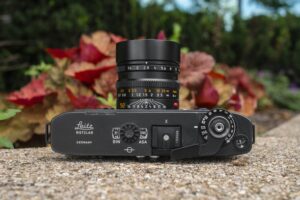
When I finally had the resources to pick up my own, I was elated to find a nice working black chrome 50 Jahre model. Not that the anniversary logo meant anything to the camera, I just thought it looked cool, and I prefer the look of the black chrome to black enamel.
As I eagerly awaited the postman to deliver my package, I was prepared for a large camera, and when it arrived I was quite surprised to see that the camera isn’t as big as I had expected. I think that the tall shoulders and totally flat top plate give the camera the look of a larger camera than it really is. Side by side next to an M3 or M4 the M5 is larger in every dimension, but compared to SLRs of the same era, the M5 is still shorter than the top of any pentaprism and about the same weight. Body only, the M5 tips the scales at 675 grams which is exactly 100 grams heavier than my M3 body, but quite a bit less than a Nikon F2 body at 882 grams.
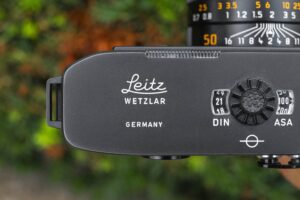
Yes, it is a big and heavy rangefinder, but not the gargantuan behemoth that its made out to be. Size and weight aside, the single thing I was most impressed with was the black chrome finish. The idea of black chrome is that it was supposed to be less chip resistant than black enamel and should wear better, but the opposite turned out to be true. Yes, the black chrome wouldn’t chip off and show bare brass, but over time the black finish would rub off revealing a dull gray finish beneath which many people thought was unattractive. For me, I like the matte finish and feel of the black chrome. In fact, I wouldn’t even describe it as true black, it is more like a very dark gray charcoal which looks different from any other camera in my collection, save for a black chrome Leicaflex SL2 I own.

Handling the M5 for the first time is a foreign experience compared to other Leica M-series cameras as it the one model that strayed from the established ergonomic norms of the M3 and M4 and what was continued on the M6 and beyond. I absolutely love the large size of the shutter speed selector and that it overlaps the front edge of the camera, allowing you to easily change shutter speeds without removing the camera from your eye. A neat feature of the shutter speed dial is that each speed from 1000 down to 1 second has a click stop, however once you go slower than 1 second, the wheel turns smoothly, without clickstops, giving you infinite variability, allowing you to dial in exactly the exposure length you need. The M5 was the first Leica to locate the shutter release in the center of the shutter speed dial, which I quite enjoyed.
The exposure counter was large and easy to read and the film advance lever was perfectly located with just the right amount of resistance so as not to feel cheap, but also not so tight as to cause difficulty in advancing the film.
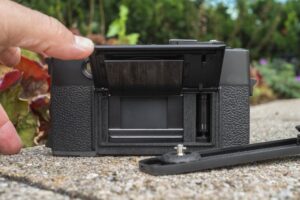
Like all M-series Leicas (including the digitals), the M5 is a bottom loader, but like the M1-M4 cameras that came before it, a hinged door on the back of the camera which can be opened after the bottom plate is removed, makes loading film into the camera easier.
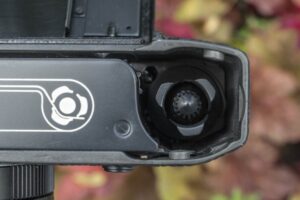
Even easier still is the new “quick load” take up spool that was introduced in the M5. This spool was redesigned from that of previous cameras and is not removable, which proved to be quite controversial to some users. The idea behind the new spool was that the film leader could be pressed into the spool from the edge, without having to trim the leader like what was recommended on all previous Leicas. The design of the new spool might not have been everyone’s favorite feature of the camera, but I quite enjoyed it. Before loading good film into the camera, I practiced with a test roll and had no issues getting the leader to attach and take up correctly on the spool. Unless I am missing something, I cannot see how anyone could not like this spool. Beyond that, loading film into the M5 is uneventful, just remember to close the door before trying to attach the bottom plate!
Is It Removable? After publishing this review, professional Leica shooter and fan of the M5, Johnny Martyr let me know that the take up spool in the M5 does actually come out if you pull on it. I attempted to try this with my camera, and I was unable to fit my fat fingers inside the take up area to sufficiently grip the spool. I attempted to use a popsicle stick to attempt to pry it out but it still wasn’t budging. Not wanting to risk damaging anything, I didn’t continue. Perhaps other M5s have an easier to remove spool, but mine was in there tight, and without any way to “eject” it, I would consider any M5 with a removable spool to be more of an ‘easter egg’ than an actual feature.
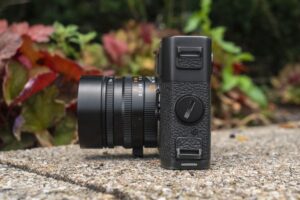
The camera’s left side is where you’ll find the battery compartment for the CdS meter, a first for a Leica rangefinder. The M5 was designed to be used with a 1.35v PX625 Mercury cell which is no longer available today. Modern alkaline equivalents can be used, but due to a voltage difference, may give erroneous readings. A professional can adapt the camera’s circuitry however to work with modern 1.5v batteries. The field of view preview switch on the front of the camera also doubles as a battery check. Simply press this lever away from the lens and if you see the needle in the viewfinder moves within a cutout area near the bottom right corner, the battery is ok.
Another cool feature of the Leica M5 is the inclusion of two strap lugs on this side of the camera. This allowed the user to connect a neck strap to the same side of the camera, allowing it to dangle without the tendency to tilt forward. Original versions of the M5 only had these two strap lugs, but a later revision added a third lug to the opposite side of the camera, allowing you to attach a neck strap in the more traditional way.
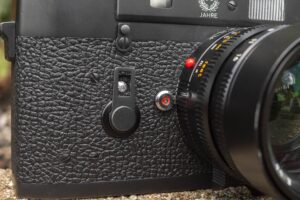
Up front, the M5 is similar to the camera before it. A large mechanical self timer lever is to the left of the lens and a tiny rewind release lever above it. To the right of the lens is a third lever is a field of view lever which also doubles as the battery check. Pressing this lever not only changes the projected frame lines in the viewfinder, but also moves the exposure needle to a visible position within the viewfinder to confirm it has proper power.
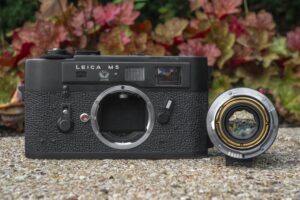
To the immediate left of the lens is the lens release button. Press and hold this button while rotating the lens counterclockwise and it will come off. Installation is the opposite of installation. Back in the era when this camera was popular, screw mount lenses were still commonly used on Leica M cameras, so a LTM to Leica M adapter was a very common accessory. A common flaw in the design of these adapters is that once they are on the camera, they can sometimes be difficult to get off, so as a solution, Leica M-mount rear lens caps had three little nubs around their perimeter which line up with divots on the adapter which can be used to grip the adapter and make it easier to get off.
Where is the Meter? The Leica M5 uses a hinged meter that pops up in front of the shutter curtain to take a reading. If you remove the lens hoping to see it, you’ll be disappointed as camera is designed to protect the meter with the lens off. If you want to see the meter, the easiest way is to install LTM to Leica M adapter to the lens mount, which will trick the camera into thinking there is a lens, and the meter will pop up.

I quite liked the viewfinder which like all modern M-series cameras is very bright and easy to use. The rangefinder patch is large and has high contrast, making it easy to use in all but the poorest lighting conditions. The projected frame lines automatically correct for parallax and automatically adjust size depending on what the focal length of lens is mounted. Below the viewfinder area is the match needle display, which shows the selected shutter speed to the left and a two needle system, a thinner diagonal line which is coupled to the shutter speed dial, and a thicker line coupled to the meter. Adjusting shutter speeds and f/stops moves the thicker needle, and as the amount of light hits the meter changes, the thicker needle moves. At whatever combination of shutter speeds and aperture, the two needles cross each other, proper exposure can be obtained. The CdS cell had a metering range of 13 EV stops, which for the time was very good, allowing for accurate metering in all but the most extreme lighting conditions.

I acquired this camera from a seller describing it in perfect working order and after confirming everything was up to snuff, I decided to take it out for its first spin. Although all of the beauty pictures of the camera in this article show the M5 with a 50mm f/1.4 Leica Summilux-M ASPH lens, I wanted to do something different and try something different. On my shelf o’ lenses saw a lonely Voigtländer Nokton 21mm f/1.4 lens in Leica-M mount. Being a fan of wide angle lenses, I decided to mount the Nokton to the M5 with a matching 21mm auxiliary viewfinder in the accessory shoe. I figured that with the extreme depth of field offered by the wide angle lens, I wouldn’t have to rely on the rangefinder much. I loaded in fresh Smena 100 I had recently picked up and took it shooting.

Shooting with a Leica is often less about image quality than it is the experience of shooting it. Leicas, whether you are using a Leitz Summilux, a Japanese made Voigtländer Nokton, or a Chinese Light Lens Lab lens, are going to consistently deliver top notch images with excellent sharpness, contrast, and without any optical aberrations found in lesser cameras.
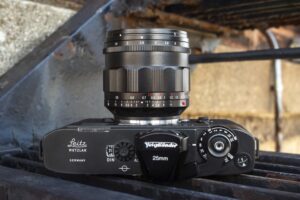
In the case of the Nokton, its ultra wide 21mm focal length and super fast f/1.4 maximum aperture are going to introduce some vignetting and softness, especially in the corners, but overall barrel distortion and all the other things people like Ken Rockwell talk about in their lens reviews, were at a minimum. This lens has the shortest focal length of any lens I’ve ever shot on a rangefinder in my life and I loved the experience. While there’s something magical about seeing a wide angle lens through an SLR pentaprism, doing it on a rangefinder, through an auxiliary viewfinder and not having to think about focus, allowed me to get through the roll of film very quickly. Me having several other Leica M-mount cameras, I definitely see myself using this lens on those other cameras.

As for the shooting experience of the Leica M5, I can definitely see why this camera has attracted a loyal following, but I can also see while dedicated Leica users were apprehensive about it when it first came out. While the addition of TTL metering and an analog display in the viewfinder was a tremendous upgrade, there’s really nothing about this camera that makes it a better photographic tool than an M3 or an M4 is. Considering the extremely high price these cameras sold for when new, I absolutely would have steered clear of it too.
Now that the Leica M5 is a bit more affordable (notice I put ‘a bit’ in italics), I think the camera is more relevant today than it was back then. For those who like both metered cameras and an analog experience, the Leica M5 is the only M-series camera with an analog match needle.
The cosmetics of the M5 are polarizing, some hate it, and others love that it looks different. I am of the latter group as I like the change from the ‘tried and true M3 design’. I actually found that the camera fit into my hands a bit better than the M3 does, and I love the larger shutter speed dial. The ability to slide your finger across the front edge of the dial to change speeds with the camera to your eye is one of those things that is difficult to convey without trying it yourself. I love this feature on the M5 the same way I do on cameras like the Canon EF, Nikon FG, and others. The viewfinder is big and bright, loading film was easier than on any other Leica I’ve loaded film in, and of course, the end results were top notch.
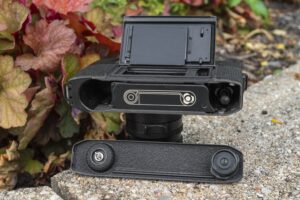
By far, the biggest con to the M5 is its size and weight. Certainly, the camera is not difficult to use as a result, but if one of the advantages of using a rangefinder over a bulky SLR is to have a more compact and portable camera, the Leica M5 takes that away. With the Nokton 21mm lens and viewfinder attached, the total weight tips the scales at a very portly 1185 grams. Comparing the M5 to an original Leica IIIa, and the difference is night and day.
If you are considering buying an M5 and can afford one, price probably isn’t going to be much of a factor for you, rather the question you should be asking yourself is whether the increased size is worth having an analog match needle in the viewfinder, a great film loading system, and one of the best shutter speed dials put on any camera ever. The Leica M5 looks like no other Leica, but uses the same lenses and makes the same great images. If that’s the camera you want, 33,900 of them were made. Mine’s not for sale, so that leaves you with 33,899 others to choose from!
Related Posts You Might Enjoy
External Links
http://camera-wiki.org/wiki/Leica_M5
https://en.wikipedia.org/wiki/Leica_M5
https://jakehornphotography.com/blog/leicam5
https://casualphotophile.com/2018/08/06/leica-m5-review/
https://dankerinphotography.com/leica-m5

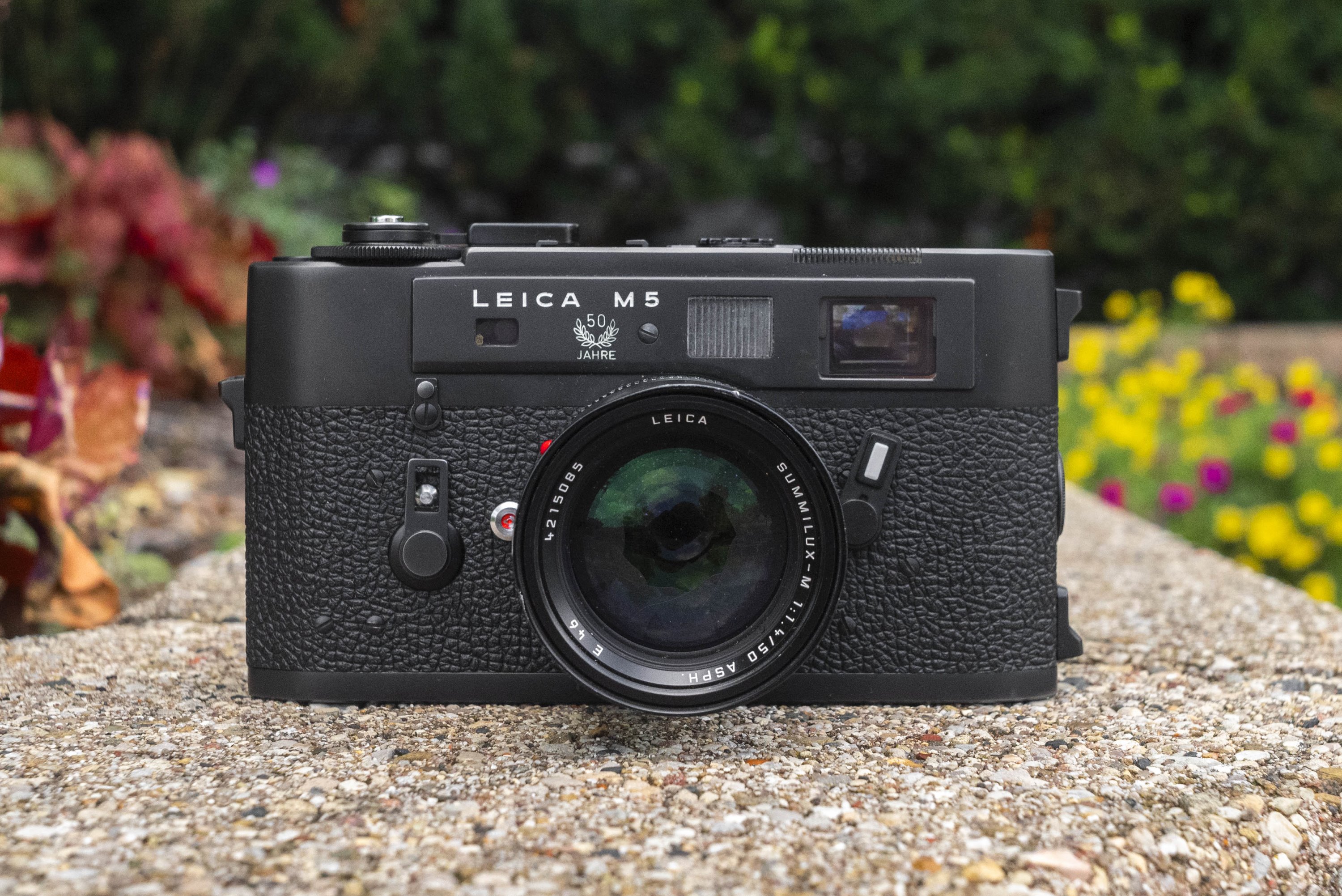

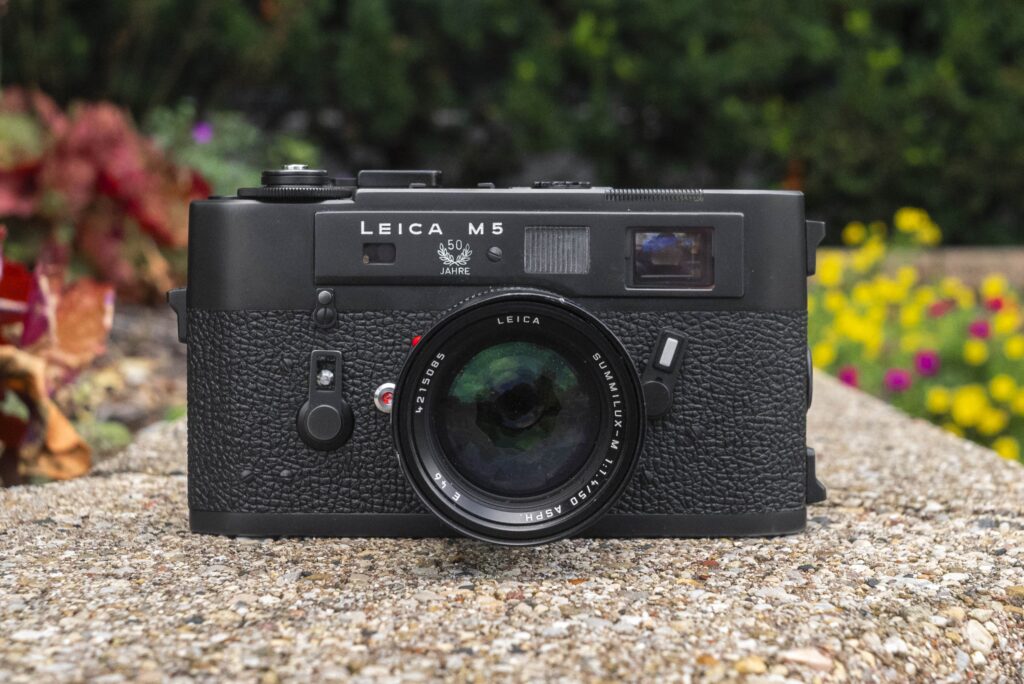
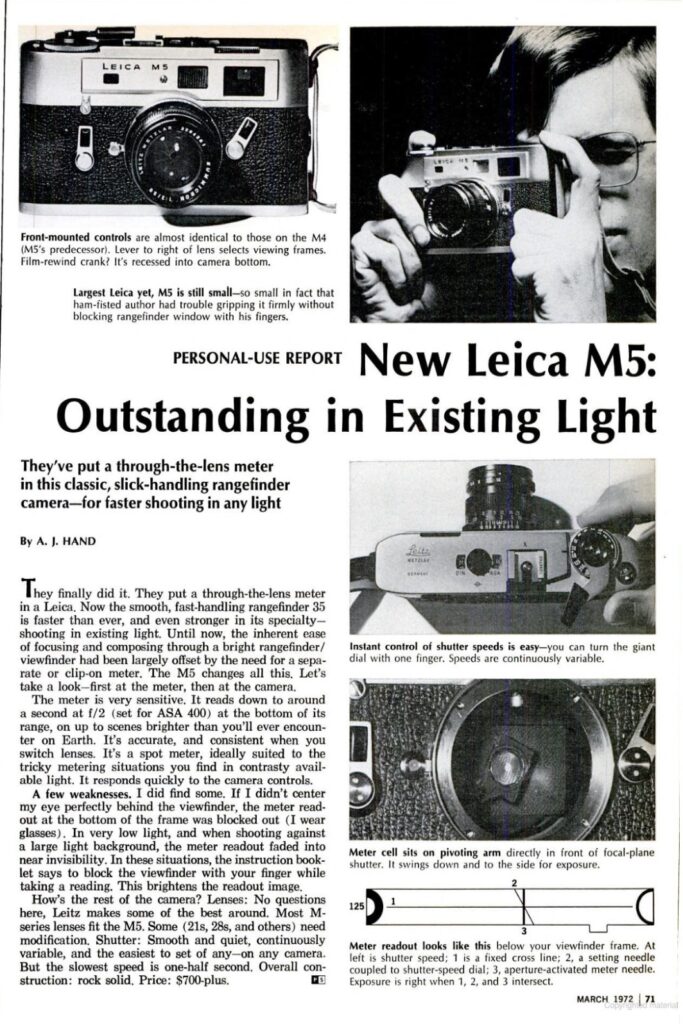
























Thank you for this interesting review. I think the M5 suffered merely because the other M’s are such beautiful cameras. Sort of like Jaguar trying to come up with the successor to the XKE. On its own, I agree that the M5 is very nice camera, well made, and with one of the quietest shutters I’ve ever used.
“…the M5 was also the first Leica M-series to abandon the design of the original M5…” You might want to rephrase this.
Nice post. I guess I will just stick with my 2 Nikon EL2’s. Enjoyed a look at the M 5.
This remind me of a story, a couple of years ago I was fixing a computer at a client house and we talked about photos and cameras. The client told me if I had knew you collected old camera I would have gave you my old film stuff. I asked what it was and he said a Leica M5 with a couple of lenses. About two weeks before he cleaned his house and dropped the stuff at a charity shop. He had no idea film camera still had value. After work I went to the charity shop but off course it wasn’t there, someone must have been really happy.
Ouch! He took a M5 and Leica lenses to a charity shop? Pity you missed out.